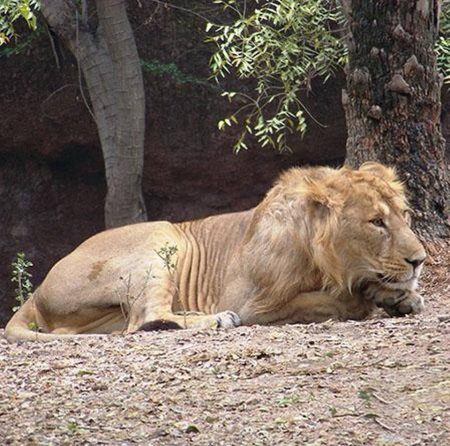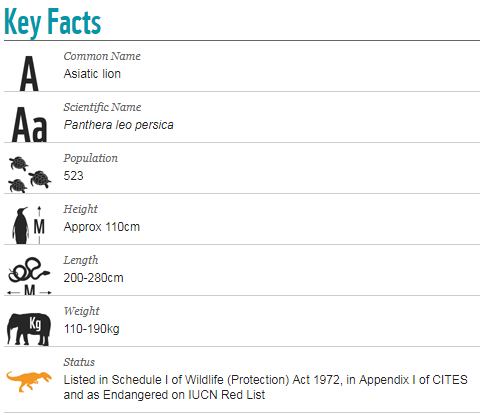Asiatic lion : Genome sequencing 16/05/2019 – Posted in: Daily News – Tags: Aisatic lion, Genome Sequencing, research
ENTIRE GENOME OF ASIATIC LION HAS BEEN SEQUENCED
For: Preliminary
Topics covered: Asiatic lions, Study’s objectives and significance, Genome sequencing
News Flash
For the first time, the entire genome of Asiatic lion, an endangered species, has been sequenced by scientists from CSIR-Centre for Cellular and Molecular Biology, Hyderabad.
- The population of the endangered Asiatic lion is very low— only 523 animals are present in the Gir forests.
The genome is estimated to be 2.3 Gb (Gigabase) long and is found to have 20,543 protein-coding genes.
Objective
- The main objective is to understand the species at DNA level.
- Another objective is to study if there are any specific problems with regard to adaptability to environment or behaviour vis-à-vis other big cats.
Significance
- This firsthand information would help better to understand the evolution of Asiatic lions and also make possible comparative analysis with other big cats.
- The genome sequencing would enable scientists to develop specific markers to study population genetics (the differences at the gene level within a population) and get newer insights into its population status and subsequent management.
- The study will enable better disease and population management of the endangered big cat by identifying characteristics which are specific to Asiatic lions.
Comparitive study
- With the complete genome of royal Bengal tiger, African Cheetah and Jaguar available, comparative studies of all these big cats would be possible.
- Only partial genomic information of the African lion was available now.
- Comparative genomics between African and Asiatic lions could be undertaken once the complete genome of the African lion is sequenced.
- Comparative analysis with other fields and mammalian genomes unravelled the evolutionary history of the Asiatic lion and its position among other fields.
Multi-pronged approach
As regards the crucial aspect of conservation of Asiatic lions, there is a need to adopt a multi-pronged approach and the study will enable better disease and population management of the endangered big cat by identifying characteristics which are specific to Asiatic lions.
Asiatic Lion
- Nearly all wild lions live in sub-Saharan Africa, but one small population of Asiatic lions exists in India’s Gir Forest.
- Asiatic lions and African lions are subspecies of the same species.
- Asiatic lions once prowled from the Middle East to India. Now, only a fraction of these magnificent animals survive in the wild.
- The Gir Forest’s dry teak woods were once a royal hunting ground. Today they are a reserve where these at-risk big cats are heavily protected.
Centre for Cellular & Molecular Biology (CCMB)
- The CCMB is a premier research organization in frontier areas of modern biology.
- The objectives of the Centre are to conduct high quality basic research and training in frontier areas of modern biology, and promote centralized national facilities for new and modern techniques in the inter-disciplinary areas of biology.
Genome Sequencing
Genome sequencing is figuring out the order of DNA nucleotides, or bases, in a genome—the order of As, Cs, Gs, and Ts that make up an organism’s DNA. The human genome is made up of over 3 billion of these genetic letters.
Why is genome sequencing so important?
- Sequencing the genome is an important step towards understanding it.
- At the very least, the genome sequence will represent a valuable shortcut, helping scientists find genes much more easily and quickly. A genome sequence does contain some clues about where genes are, even though scientists are just learning to interpret these clues.
- Scientists also hope that being able to study the entire genome sequence will help them understand how the genome as a whole works—how genes work together to direct the growth, development and maintenance of an entire organism.
Source: The Hindu
You can follow us on LinkedIn and for more updates related to UPSC IAS Preparation, Like our Facebook Page and subscribe our Diligent IAS Youtube Channel
Also Read Related Daily News


